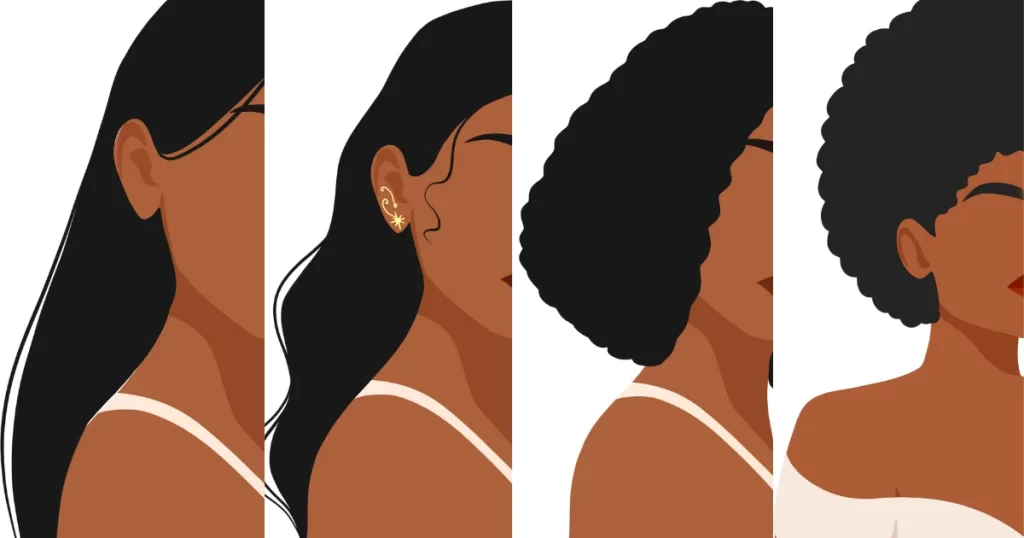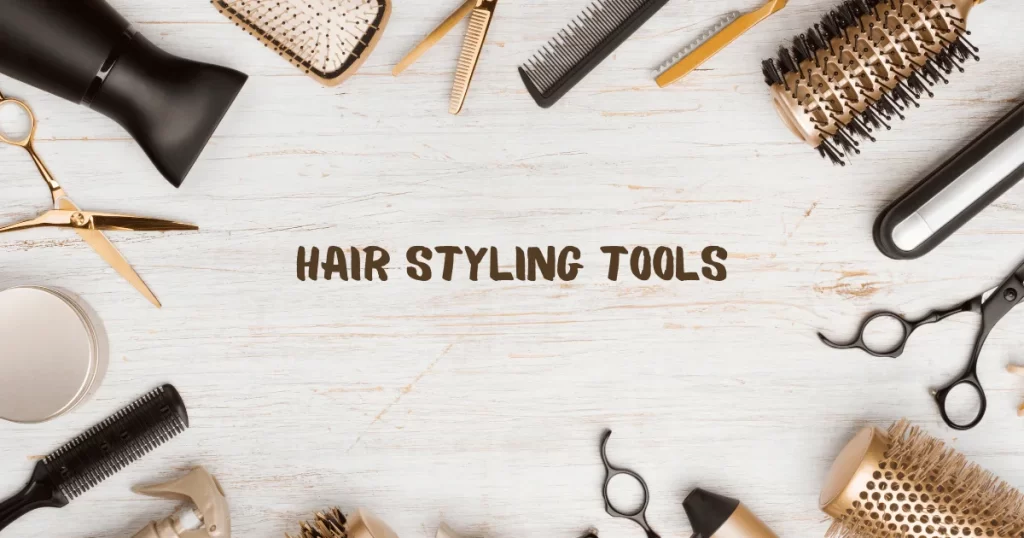Are we tired of constantly seeking hair care advice from influencers, only to end up feeling disappointed? It’s time to break that cycle and direct your attention to what truly matters: understanding your unique hair type and its specific requirements. Uncertain about your hair type? No problem. Here are some insights to help you identify it and wholeheartedly embrace your gorgeous locks.
Unlocking Your Hair’s Secrets: Know Your Hair Type
Understanding your hair type is the foundation of successful hair care, similar to how knowing your skin type is vital for skin care. Once you pinpoint your hair type, considering factors like density, texture, porosity, elasticity, and curl pattern, you’ll be equipped to make informed choices regarding products and methods to maintain the health and beauty of your hair. Let’s delve into the fundamentals of identifying your hair type.
Your Natural Hair Pattern and Texture

Your hair’s natural pattern, texture, and form are as individual as you are. Recognizing your hair type is important because it paves the way for selecting the ideal care and styling techniques tailored to your specific hair characteristics.
And the most exciting part? Determining your hair type is far from a complex task; you don’t need to possess the skills of a cosmetologist to do it.
Hair types generally fall into four categories: straight, wavy, curly, and coily. However, you’ll discover various curl patterns and textures in these categories.
The secret to identifying your hair type, try this simple trick: run your fingers through your hair when it’s damp. Is your hair straight, and lightly wavy, or does it form captivating spirals?
Hair Typing System and Curl Patterns
You’ve probably heard of the Andre Walker Hair Typing System. Walker’s system breaks hair down into four primary categories:
Type 1 (Straight)
Type 2 (Wavy)
Type 3 (Curly)
Type 4 (Coily)
Now examine your hair when it’s clean, without any products. Remember, it’s perfectly fine if you have a mix of types. Many of us do.
Let’s break it down by hair type:
Type 1 – Straight Hair: If your hair is sleek and straight, it’s all about simplicity.
Type 2 – Wavy Hair: Wavy hair with gentle S-shaped waves may have a touch of frizz.
Type 3 – Curly Hair: Curly hair forms distinct curls, ranging from loose to tight.
Type 4 – Coily Hair: Coily hair is the queen of texture with a natural zigzag pattern, often referred to as “kinky” or “afro-textured.”
Discovering Your Hair Type
Understanding Hair Texture
Hair texture encompasses the natural shape or pattern of your hair strands and remains a critical factor, irrespective of the specific elements addressed by a hair type chart. Hair exhibits a diverse range of textures, spanning from fine to coarse.
Determining your hair’s thickness involves a simple test with an everyday item – standard sewing thread, typically 6-8 inches in length. It’s essential to use regular sewing thread, not the thicker variant intended for heavy-duty fabrics. For the most precise results, your hair should be dry and devoid of any styling products during the assessment.
Pluck a strand from the crown of your head and place it next to the thread on a white sheet of paper. This setup allows you to make a direct comparison regarding their thickness, colour, and texture.
Deciphering Your Hair Texture
Here’s how to interpret the results for different hair textures:
Type 1
Fine Straight Hair (Type 1a): Silky and soft, but can lack volume. Use lightweight, volumizing products. Consider a layered haircut for added body and bounce.
Medium Straight Hair (Type 1b): Versatile and balanced, handleable with various styles and products. Opt for moderate products that provide moisture and nourishment.
Coarse Straight Hair (Type 1c): Thicker and somewhat resistant to styling. Benefit from smoothing products and a good hair straightener. Deep conditioning treatments can help manage its natural thickness.
Type 2
Fine Wavy Hair (Type 2a): Delicate and prone to frizz. Opt for lightweight, moisture-rich products. Use curl-enhancing products for those S-shaped waves.
Medium Wavy Hair (Type 2b): A balance between straight and curly. Use hydrating shampoos and conditioners to maintain natural movement. Consider a layered haircut for dimension.
Coarse Wavy Hair (Type 2c): Thicker with more pronounced waves. Combat frizz with anti-frizz serums and creams while enhancing shine.
Type 3
Fine Curly Hair (Type 3a): Soft but may lack volume and definition. Deep conditioning and lightweight curl-enhancing products help achieve bouncy, defined curls.
Medium Curly Hair (Type 3b): A mix of volume and definition. Moisturizing shampoos, conditioners, and medium-hold styling products maintain those beautiful ringlets.
Coarse Curly Hair (Type 3c): Thick with well-defined curls. It thrives on moisture, so deep conditioning and leave-in conditioners maintain its shape and shine.
Type 4
Fine Kinky Hair (Type 4a): Delicate and prone to breakage. Craves moisture and gentle care. Use sulphate-free shampoos, deep condition, and minimize heat styling.
Medium Kinky Hair (Type 4b): Thicker and resilient. Hydration is crucial, and protective styles like braids and twists are options for healthy, fabulous hair.
Coarse Kinky Hair (Type 4c): The thickest, with tight coils or zig-zags. Requires intense hydration and regular deep conditioning with natural oils like coconut or shea butter to maintain shape and shine.

Hair Density: Understanding Your Hair’s Volume
Hair density, which signifies the number of individual strands on your scalp per square inch, significantly influences the overall appearance and thickness of your hair.
Determining your hair density is a straightforward process. Simply part your hair down the middle, and your scalp’s visibility will provide the answer.
If your scalp is easily seen, you have low density. If there is some visibility but not too much, your density falls into the medium category. When your scalp is barely visible, you boast high density.
The Connection Between Hair Density and Texture
Hair density and texture share a close association, yet they are distinct aspects. Let’s delve deeper into this relationship:
Low Density with Fine Hair: Characterized by thin strands that lack volume, opting for volumizing products and hairstyles that create the illusion of thickness is the key. Consider a layered haircut for added depth and movement.
High Density with Coarse Hair: Revel in the fullness and lush appearance, but be vigilant about frizz. Select moisture-rich products to manage frizz and embrace leave-in conditioners to nurture health and manageability.
Medium Density with Medium Hair: This zone embodies balance. Here, you can experiment with an array of styles, from sleek and straight to curly and wavy. Prioritize your hair’s well-being and maintain moisture in every choice you make.
Hair Porosity: Your Hair’s Moisture Retention Capacity
Hair porosity, which defines your hair’s capacity to absorb and retain moisture and products, is similar to your hair’s distinct “character.” It determines your hair’s behaviour and how it reacts to styling endeavours, rendering it a pivotal aspect in the choice of suitable products and care routines.
Testing your hair’s porosity is a straightforward process as well, just place a strand in a glass of water. If it floats, it typically signifies low porosity. If it descends slowly, it falls into the category of normal porosity. If it sinks swiftly, your hair demonstrates high porosity.
Now that you’ve deciphered the porosity puzzle, here’s how to tailor your care routine:
Low Porosity: Rough and dry, this hair type struggles to retain moisture.
Medium Porosity: Retains a moderate amount of moisture, feeling damp but not sticky.
High Porosity: Holds a lot of moisture, feeling sticky and slow to release water.
Understanding Your Hair’s Natural Oil Production
It’s crucial to have insight into the natural oil production of your hair. The level of oiliness in your hair is governed by the activity of your scalp’s sebaceous glands, which can evolve and be influenced by external factors like shampoos and hair dyes.
This understanding is vital for effective hair management. Depending on the sebum production of your scalp, your hair can fall into the categories of dry, normal, or oily.
Determining Your Hair’s Oil Level: A Simple Guide
- Wash your hair and let it air dry.
- Avoid using any hair products.
- Let your hair sit for 8-12 hours.
- Press a tissue against your scalp, particularly at the crown of your head and behind your ears.
Let’s decipher the Results:
- If there is oil residue on the tissue, you have oily hair.
- A slight trace of oil suggests medium hair.
- If nothing is on the tissue, your hair is dry.
If you notice varying oil levels in different areas of your scalp, you probably have combination hair.
By following these simple steps, you can accurately determine the natural oil level of your hair and tailor your hair care routine accordingly.
Hair Elasticity: A Cornerstone of Hair Health
Hair elasticity is fundamental for maintaining healthy hair. It reveals the extent to which your hair can stretch and rebound to its original length without experiencing breakage.
Hair with reduced elasticity is more susceptible to damage and breakage. To gauge this, simply take a strand of freshly washed, towel-dried hair and gently pull it to observe how much it can stretch before breaking.
Extensive stretching denotes high elasticity and robust hair. If it snaps after some stretch, it suggests medium elasticity, whereas immediate breakage indicates low elasticity and more fragile hair.
In Conclusion
Our hair serves as a mirror of our beauty. Irrespective of your age or specific hair type, there are ways to elevate the health and allure of your locks.
I trust this guide has adeptly steered you through the realm of hair care, emphasizing its significance, from unravelling your unique hair type to nurturing beneficial habits.
Embrace your hair, cherish it, and always remember, you are inherently beautiful just as you are! Should you have inquiries or stories to share, don’t hesitate to reach out; we’re here for you.



